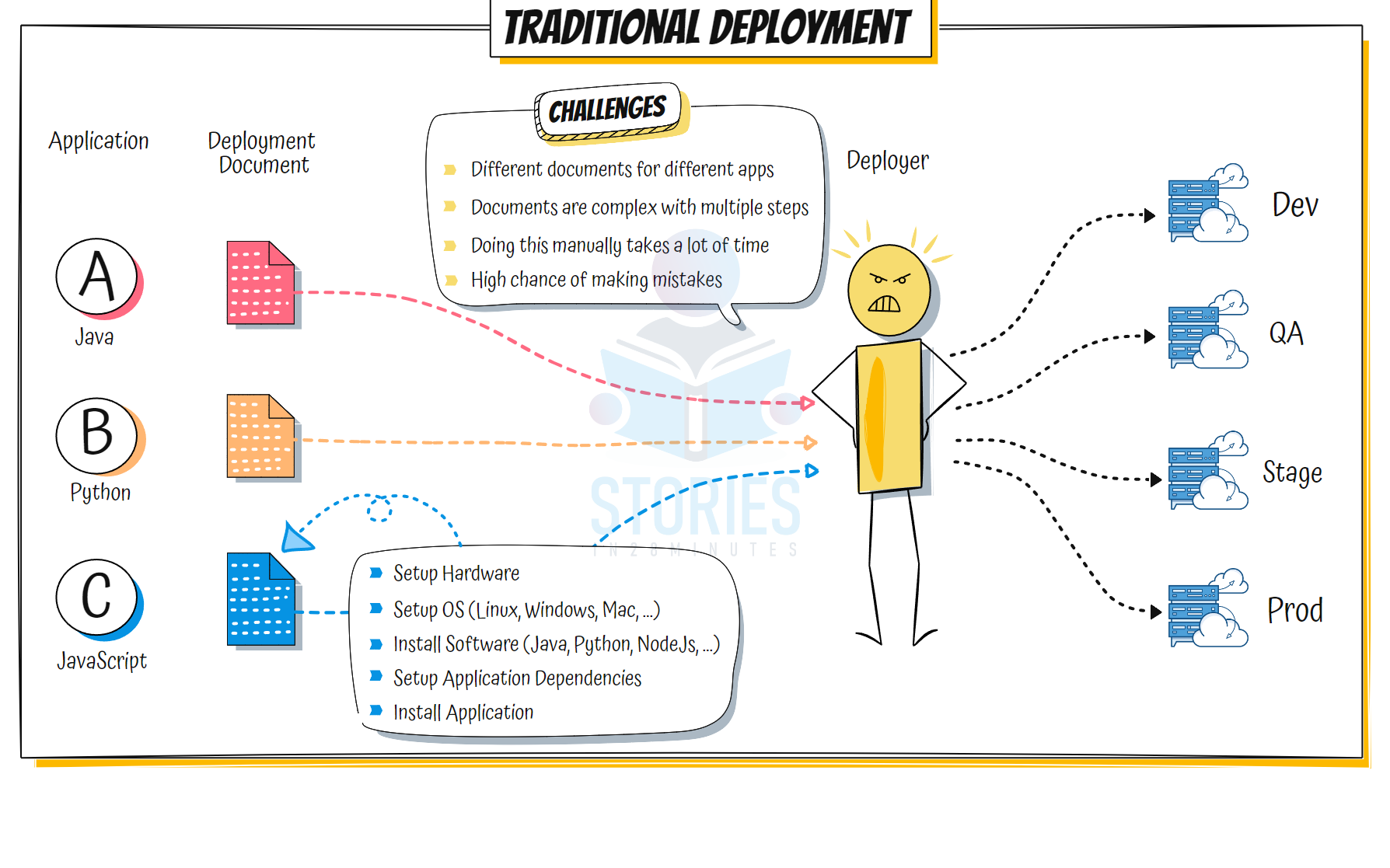What was the Traditional Deployment Approach Before Containers? #

- Documentation-Based Deployment: A document details the steps for creating environments and deploying software
- Hardware Setup: Preparing physical servers or virtual machines
- OS Installation: Installing operating systems like Linux, Windows, or Mac
- Software Installation: Set up essential software such as Java, Python, or Node.js
- Dependency Configuration: Install and configure application dependencies and libraries
- Application Deployment: Install and configure the actual application on the system
What are the challenges with Traditional Deployment Process? #
- Multiple setup steps: Setting up OS, software, and dependencies repeatedly can be tedious
- Time-consuming process: Manually performing these steps across multiple environments (Dev, QA, Stage, Prod) takes a lot of effort
- Lack of automation: Traditional methods lack automation
- High chance of mistakes: Numerous manual steps and separate documents increase the likelihood of errors
- Different documents: Each application - depending on its type (Java, Python, JavaScript) - needs different kind of setup instructions
Can you explain the sequence of steps in creating and deploying a Container Image? #
- Build Container Image: Create a Container image of your application with necessary components
- Push Image to Container Registry: Upload your created image to the registry for later use.
- Deploy it to Your Environment: Pull the image from the registry and run your application
- Same approach in Local, DEV, QA, Stage, Production,..
What are the Advantages of using Docker? #
- Standardized Deployment Package: Same packaging approach irrespective of programming language
- Standardized Deployment Process: Run any Container image the same way, regardless of its contents
- Standardized Operations: Collect logs, metrics, and traces the same way, regardless of the container
- Lightweight Alternative to VMs: Uses fewer resources, making it faster and more efficient
Compare Virtual Machines (VM) and Containers #
| Feature | VMs | Containers |
|---|---|---|
| Architecture | Complete virtualized computers with their own OS, running on a hypervisor | Lightweight, sharing the host OS core, running using Container Engine |
| Performance | Resource-intensive - Each VM contains full OS | Lightweight, shares host OS |
| Boot Time | Slower, full OS startup | Faster, shares host OS |
| Resource Usage | Consumes more CPU, memory, storage | More efficient resource usage |
| Image Size | Larger, includes a full OS | Smaller, only app and dependencies |
| Security | Stronger, separate OS for each VM | Shared OS kernel but container engine ensures isolated processes for each container |
Explain Important Components in Container Architecture #
- Container Image: A package representing a specific version of your application, containing everything needed to run it
- Complete Package: Includes the Operating System, Application Runtime, and Application Code & Dependencies
- Consistent Deployment: Ensures your app runs the same way everywhere, from your local machine to cloud servers
- Container Engine: The core software that runs and manages containers
- Run your Container Images: Creates containers
- Container Registry: Storage location for Container images
- Examples: Docker Hub, Amazon Elastic Container Registry, Google Artifact Registry, Azure Container Registry
- Collaboration: Facilitates easy distribution of container images across teams
- Integration: Works with CI/CD systems for automated building and deployment
- Discovery: Acts as a discovery mechanism for official and community images
- Container Repository: A collection of Container images for a specific app
Why is Containerization important for DevOps and Microservices? #
What is Containerization?
- Definition: Package app + dependencies into one container
- Goal: Run app the same everywhere – dev, test, prod
- Tools: Popular tool is Docker. Alternatives include containerd, runc, ..
Why is it Important in DevOps?
- Consistent Environments: Same setup from dev to prod
- "Works on My Machine" Solved: Containers avoid environment mismatch
Containerization Simplifies Deployment
- Faster Setup: No need to install libraries manually
- Less Errors: Fewer issues due to missing dependencies
- Quick Start: Run app with one command
Containerization Promotes Automation
- Automated Image Creation: Automatically build container images
- Works with CI/CD: Integrate with tools like Jenkins or GitHub Actions
- Supports Orchestration: Use Kubernetes to manage many containers
Containerization Simplifies Microservices Architectures
- Create microservice specific container images: Create different container images for each of the microservices
- Same Process For Different Technology: Same process irrespective of technology used in a microservice - Java, Python, Node.js or ..
- Scale Easily: Add or remove containers as needed
- Containers Improve Observability: Get Logs, Metrics and Traces for different types of applications the same way
Containers are Platform Neutral
- Same Image Everywhere: Build once, run anywhere
- Run Anywhere: Works on local, server, or cloud
- Cloud Ready: Compatible with AWS, Azure, GCP
Containers are Resource Efficient
- Lightweight: Host OS is shared
- Faster Start-up: Containers launch quickly
- Higher Density: Run more containers (than VMs) on same hardware